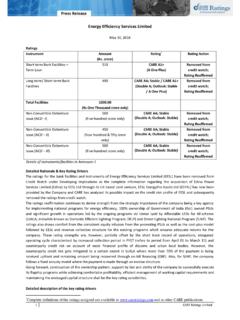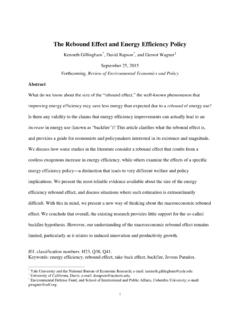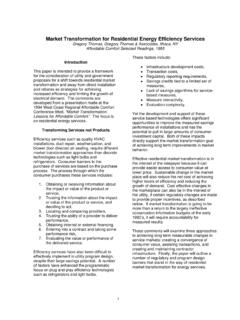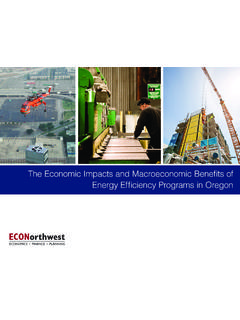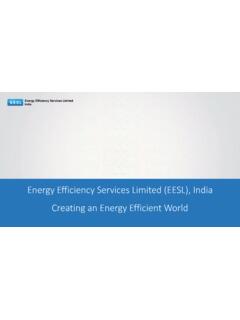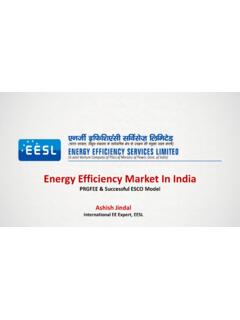Transcription of Bureau of Energy Efficiency (BEE) - SAMEEEKSHA
1 MANUAL ON Energy CONSERVATION MEASURES IN TEXTILE CLUSTER SURAT, GUJARAT Bureau of Energy Efficiency (BEE) Ministry of Power, Government of India Prepared By Zenith Energy services Pvt. Ltd., Hyderabad MANUAL ON Energy CONSERVATION MEASURES IN TEXTILE CLUSTER SURAT 1 Manual on Energy Conservation Measures in Textile Cluster CONTENTS ACKNOWLEDGEMENT .. 6 CHAPTER 1 INTRODUCTION .. 7 About BEE S SME Program .. 7 Project Objectives .. 8 Expected Project Outcome .. 9 Energy Use and Technology Analysis .. 10 Implementation of EE measures .. 10 Capacity Building of LSP s and Bankers .. 10 Project Duration .. 11 Identified Clusters under the BEE SME Program .. 12 About the present study .. 13 Structure of the Report .. 14 CHAPTER 2 ABOUT SURAT CLUSTER .. 15 OVERVIEW OF SURAT SME CLUSTER.
2 15 Cluster Background .. 15 Products Manufactured .. 16 CLASSIFICATION OF UNITS .. 16 Classification Based On Production Capacity .. 16 Classification Based On Production Facilities .. 17 Classification Based On Annual Energy Bill .. 18 .. 19 a) Classification Of Units of 75 Units Surveyed .. 19 b) Classification Of Units Based On Production Facilities .. 19 c) Classification Of Studied Units Based On Annual Energy Bill .. 20 RAW MATERIALS .. 21 Energy SCENARIO OF THE CLUSTER .. 21 Fuels Used And 21 Energy Consumption .. 22 Specific Energy Consumption .. 23 MANUFACTURING PROCESS .. 23 2 Manual on Energy Conservation Measures in Textile Cluster Process Technology .. 23 Fabric pre-treatment .. 23 Dyeing .. 24 Printing .. 27 CURRENT POLICIES AND INITIATIVES OF LOCAL BODIES .. 31 About GEDA.
3 31 GEDA Energy Audit Scheme .. 31 Scheme for Mass Scale Walk-through Energy Audit of SMEs in Gujarat Background32 Improving Energy Efficiency in Small & Medium Enterprises (SMEs) .. 32 Energy Audit Scheme For SMEs of Gujarat .. 33 Scope of the Scheme .. 33 MAJOR BARRIERS FOR IMPLEMENTATION OF Energy Efficiency MEASURES .. 34 Energy Availability .. 34 Technological Issues .. 34 Lack Of Technical Know-How & Organizational Capacity .. 35 Financial Issues .. 35 CHAPTER 3 Energy AUDIT AND TECHNOLOGY ASSESSMENT STUDY .. 36 METHODOLOGY ADOPTED .. 36 Energy use and Technical Assessment study .. 36 Pre- Energy audit activities .. 36 Preliminary Energy Study .. 36 Detailed Energy Study .. 37 Technical Audit .. 37 OBSERVATIONS MADE .. 38 Manufacturing Process And Technology Employed .. 38 Energy Consumption profile .. 40 Lignite/ Imported coal and Natural gas .. 40 Electricity .. 41 Capacity Utilization.
4 43 Housekeeping 43 Availability of data and Information .. 43 Any other relevant Aspect .. 43 3 Manual on Energy Conservation Measures in Textile Cluster TECHNOLOGY GAP ANALYSIS .. 44 Technology up-gradation .. 44 Process 44 Energy CONSERVATION MEASURES IDENTIFIED .. 47 Description of proposals including technology/product specifications .. 47 Life Cycle Analysis For The Suggested Energy Saving Proposals .. 71 Cost benefit analysis .. 73 Issues/barriers in implementation of EE proposals .. 76 Availability of Technologies in Local / National / International market .. 76 Availability of LSPs for Implementation of suggested proposals .. 77 Identification of Technologies/Equipments for DPR preparation .. 77 ENVIRONMENTAL BENEFITS .. 78 CHAPTER 4 CONCLUSIONS .. 80 Summary of Energy saving measures identified for the Cluster.
5 80 Technology gap assessment for Energy saving proposals Identified for the Cluster .. 81 Techno Economic analysis for suggested Energy saving proposals .. 85 Barriers in Implementation of identified Energy saving proposals .. 87 Short listed Technology/Products for DPRs .. 88 Summary of level of awareness on Energy savings and Energy saving Technologies in Surat Cluster .. 88 LIST OF ANNEXURE .. 89 ANNEXURE 1 .. 89 ANNEXURE 2 .. 92 ANNEXURE 3 .. 94 ANNEXURE 4 .. 97 Annexure-1 :House Keeping Annexure -2: Details of technologies/ Service providers for the Annexure- 3:Name and Address of units in the LIST OF FIGURES Figure 1: Project Figure 2: Classification of units based on production 4 Manual on Energy Conservation Measures in Textile Cluster Figure 3: Classification of units based on production Figure 4: Classification of units based on Energy Figure 5: Classification of units based on production Figure 6: Classification of units based on production Figure 7: Classification of units based on Energy Figure 8: The process adopted for dyeing of Figure 9: The process adopted for printing of Figure 10: Process flow Figure 11: Schematic diagram of natural gas co-generation system.
6 34 Figure 12: Schematic diagram of proposed cogeneration Figure 13: Energy conservation Figure 14: Schematic diagram of heat recovery Figure 15: Schematic diagram of online oxygen Figure 16: Steam trapping system ..39 LIST OF TABLES Table 1: List of clusters identified for BEE SME Table 2: Details of studies under taken in cluster Table 3: Prevailing price range of fuels in the Table 4: Annual Energy consumption of typical Table 5: Specific Energy Table 6: Fuel prices in the Table 7: Specific electricity Table 8: Technology gaps identified and technology Table 9: Cost benefit analysis of installing natural gas Table 10: Cummins natural gas generator Table 11: Technical specifications of cogeneration Table 12: Cost Benefit Analysis of Energy conservation 5 Manual on Energy Conservation Measures in Textile Cluster Table 13: Cost Benefit Analysis of heat recovery from hot drained water of jet Table 14: Performance evaluation of Table 15: Cost Benefit Analysis of installing new enegy efficient Table 16.
7 Select technical details of Energy -efficient Table 17: Cost Benefit Analysis of installing VFD Table 18: Cost Benefit Analysis of installing Energy efficient Table 19: Technical specifications of Energy -efficient pumps for various capacities of Jet Table 20: Cost Benefit Analysis of online flue monitoring Table 21: Oxitec 5000 - Online Oxygen Table 22: Cost Benefit Analysis of condensate Table 23: Life cycle analysis for Energy saving proposals Table 24: Details of cost of Table 25: Energy saving details for the suggested Energy saving Table 26: Details of technologies available for the suggested Table 27: The list of technologies for DPR Table 28: Summary of Energy saving proposals identified for Surat Textile Table 29: Technology gap assessment for the suggested Energy saving Table 30: Techno Economic analysis for various Energy saving proposals Table 31: Barriers in implementation for various Energy saving proposals 6 Manual on Energy Conservation Measures in Textile Cluster ACKNOWLEDGEMENT Zenith Energy services Pvt.
8 limited (ZESL) places on record its sincere gratitude to the Bureau of Energy Efficiency (BEE), Ministry of Power, Government of India for giving us an opportunity for implementation of BEE SME program for Energy Efficiency improvement at Surat Textile Cluster, Surat, Gujarat State . We express our gratitude to the below mentioned BEE officials for their support and guidance in preparation of the cluster manual for Surat Textile Cluster above project: Dr. Ajay Mathur, Director General, BEE. Shri Saurabh Kumar, Secretary, BEE. Shri Jitendra Sood, Energy Economist, BEE. Shri Pawan Kumar Tiwari, Advisor (SME). Shri Gaurav Kumar, Project Engineer. Zenith Energy services Pvt. Ltd. is thankful for the support and co-operation to Chaudhary, President (SGTPA) and Malpani, Chairman (PEPL), Surat, Gujarat. Zenith Energy services Pvt. Ltd. is also thankful to the South Gujarat Textile Processors Association (SGTPA) and Palsana Enviro Protection Ltd.
9 (PEPL) , for their valuable inputs, cooperation and support extended towards identification of the units to undertake Energy Use and Technology Audit and for preparation of the manual on Surat Textile cluster. We take this opportunity to express our appreciation for the excellent support provided by various SME owners, local service providers, and equipment suppliers for their active involvement and valuable inputs in making the studies successful and in completion of the cluster manual. Zenith Energy services Pvt Ltd is also thankful to all plant in charges and workers of the SME units for their support during the Energy Use and Technology Audit studies and in implementation of the demonstration projects. ZENITH Energy services PVT limited HYDERABAD 7 Manual on Energy Conservation Measures in Textile Cluster CHAPTER 1 INTRODUCTION About BEE S SME Program The Government of India has enacted the Energy Conservation Act 2001 due to high Energy saving potential in industries, agriculture, domestic and transport sectors; to reduce the gap between demand and supply; to reduce environmental emissions through Energy saving; and to effectively overcome the barriers.
10 The Act provides the much-needed legal framework and institutional arrangement for embarking on an Energy Efficiency drive. The Bureau of Energy Efficiency (BEE), an agency of the Union Ministry of Power, has introduced a programme BEE SME Program to help small and medium enterprises (SMEs) to use Energy efficiently. As a part of the implementation of BEE-SME Programme about 35 SME clusters were identified. After ground-level situation analysis, 25 of them have been selected for further activities in consultation with the Ministry of Micro, Small and Medium Enterprises (MoMSME). According to the Indian Institute of Foreign Trade, SMEs contribute about 6% of the country s GDP. Although Energy is an important input required for economic and social development, attaining higher Energy Efficiency is considered an important element in meeting India s future Energy challenges and ensuring its Energy security.
